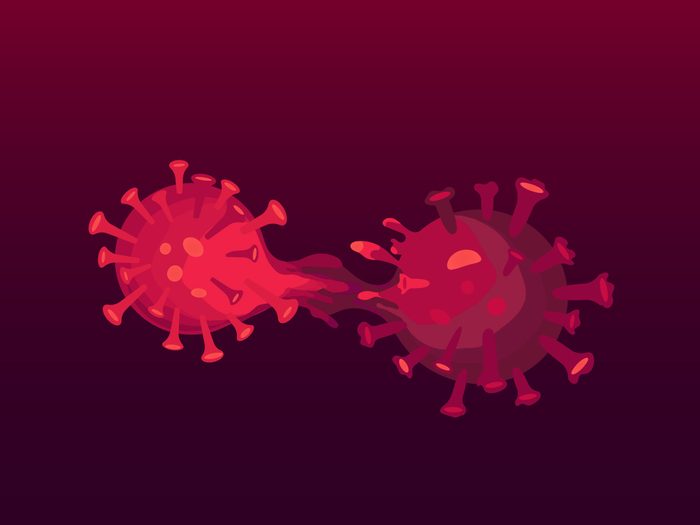What Makes Omicron Different Than Other COVID Variants?

Dr. Seema Marwaha answers this and other FAQ about the new COVID variant.
Last December, the World Health Organization (WHO) coined the term variant of concern (VOC), describing variations of the COVID-19 virus that were more contagious and better able to evade our public health defences. Almost a year later, it’s hard not to feel a sense of déjà vu going into this holiday season.
On November 26, the WHO added a fifth strain of SARS-Co-V2—termed the Omicron variant—to its list of VOCs. The global organization warned that the new COVID variant is one of the most highly mutated strains of the COVID virus identified to date.
The first VOCs to be identified were the Alpha and Beta variants in December of 2020 followed by the Gamma variant in January. And then the highly transmissible Delta variant was identified in the spring, the predominant strain causing infections worldwide today. While it’s common for viruses like COVID-19 to change genetically over time, some mutations change the virus’s core properties—like how easily it spreads.
The highly mutated Omicron variant was identified in South Africa on November 9, and several cases have been identified across Canada. With little known about this new strain of SARS-Co-V2, scientists and public health professionals are working overtime to understand how Omicron might alter the trajectory of the pandemic and the efficacy of vaccines. And many Canadians are wondering how the identification of this variant will impact our lives over the holidays and into 2022. Our understanding is constantly evolving, but here is what we know so far.
We’ve already seen multiple COVID variants of concern, what makes this one different from the others?
Omicron sparked immediate concern because of the sheer number of genetic mutations it has—over 50 mutations in total. There are more than 30 mutations to the spike protein alone, the part of the virus that binds to human cells and helps it to gain entry. As a comparison, the Delta variant has only two mutations to the spike protein. The spike protein is the main target of the antibodies we produce to fight a COVID-19 infection. The worry is that Omicron’s mutated spike protein might be able to somewhat evade our antibodies.
Scientists are also worried these mutations might give Omicron the potential to be more transmissible.
What makes this a new COVID variant and not a completely new virus?
For the COVID virus to cause infection, it must hijack a human host cell and use the cell’s machinery to reproduce itself. Errors often occur during the process of duplicating the virus’s RNA, causing changes to the virus’ genetic code. This results in viruses that are similar (i.e. variants), but not exact copies of the original virus.
Even though each variant has a slightly different genetic code, they all can be traced back to a common ancestor, the original SARS-CoV-2 virus. This is what makes it a variant and not a new virus.
With Delta, the concern was about how easily it could be transmitted. What do we know about Omicron? Is it more infectious?
Early reports from South Africa indicate the Omicron variant of coronavirus may be more contagious than previous variants. This is because Omicron has quickly become the dominant strain of COVID-19 in South Africa’s Gauteng province, where cases are doubling every day. A Hong Kong study publicized in mid-December found that the Omicron variant infects and multiplies 70 times faster than the Delta variant and original SARS-CoV-2 virus. Researchers from the faculty of Medicine at the University of Hong Kong say that these results explain the explosive increase in COVID-19 cases in countries around the world.
Does Omicron cause more severe illness? Are the symptoms the same as COVID or are we seeing new symptoms from this variant?
It is still too early to determine how virulent Omicron is relative to other variants of COVID. And for context, there is still debate as to whether the Delta variant causes more severe disease than previous strains.
That said, there is currently no information to suggest that symptoms associated with Omicron are different from those from other variants. Of the cases seen so far in Europe, South Africa and the U.S., fatigue, headache and body aches are commonly reported in those who test positive for Omicron. Symptoms like loss of smell and shortness of breath have been less prevalent.
More definitive data is needed to make any firm conclusions about illness severity, hospitalization rates and other symptoms.
Are certain demographics more susceptible to Omicron infections or worse outcomes?
And it is too early to be sure how the variant might affect the elderly, children or other members of high-risk groups. But what we do know is that, as with all strains of COVID, being unvaccinated puts you at a significantly increased risk for contracting and spreading infection. Very early reports out of South Africa suggest a higher pediatric hospitalization rate in children under 5 who are ineligible to get the vaccine.
In terms of vaccine coverage, around 56 percent of the eligible global population have received at least one COVID-19 vaccine dose as of the end of November. But for low-income countries, at time of publication, the rate was just 7.5 percent.
As long as poorer nations still struggle to obtain vaccines, there will be ample opportunity for SARS CoV-2 to replicate and mutate among the unvaccinated around the world, leading to more variants. And as evidenced by the rapid spread of Delta around the world, a dangerous new variant is unlikely to remain in one place for very long.
Since this variant is so different, are the vaccines we have going to be less effective?
Both the Pfizer and Moderna vaccines have remained effective against all other known variants identified so far during the pandemic, with some variability in effectiveness depending on the particular variant. We are not back to square one when it comes to vaccines. There is no reason to believe Omicron will be completely vaccine-resistant and many experts believe we will still see good protection against severe illness and death.
Across Canada, provinces are making Moderna and Pfizer-BioNTech booster shots available. Evidence is increasingly showing that three COVID vaccine doses better protects against the Omicron variant—so once eligible, it is highly recommend to get that third dose.
Vaccines are expected to provide some protection against Omicron because they stimulate not only neutralizing antibodies but other immune cells that attack virus-infected cells. While mutations to the spike protein can hinder our antibody response, the other parts of our immune system are unaffected by these mutations and are likely instrumental in preventing serious illness and death.
Vaccine makers—including Moderna and Pfizer-BioNTech—are studying vaccine effectiveness against Omicron and believe they can make tweaks to their vaccine formulation to better target emerging variants. Pfizer recently announced a three-shot course of their vaccine was able to neutralize the Omicron variant in a laboratory test, suggesting rolling out third doses could improve our response to Omicron.
Does the Omicron variant show up on existing COVID tests?
The available commercial diagnostic PCR (polymerase chain reaction) and antigen COVID tests still appear to work to identify the omicron variant. We will know more in the coming weeks about how well the rapid at-home tests perform to detect the new variant. Provinces including Nova Scotia, Ontario and Alberta have taken steps to provide free take-home tests to the public.
How can Canadians protect themselves?
The key right now is to stick with the toolbox of defences that we have developed over the last almost two years.
Encourage all of your eligible family members to get fully vaccinated as soon as they can. It is crucial for unvaccinated individuals to get their shot and eligible individuals to get their booster dose.
Be sure you have a well-fitting mask and wear it in indoors when outside of your home. In addition, maintaining our other key public health measures is also essential. This includes social distancing, ensuring adequate ventilation of indoor spaces and hand hygiene. Avoid potential ‘super-spreader’ situations—like crowded places with unvaccinated or unmasked individuals.
And even if you are fully vaccinated and healthy, consider using rapid antigen testing prior to attending any gatherings before and after the events as an added precaution.
Dr. Seema Marwaha is a general internal medicine physician in Toronto and an assistant professor at the University of Toronto’s Department of Medicine. She is also the editor-in-chief of Healthy Debate.
Next: Everything You Need to Know About COVID Antiviral Pills




